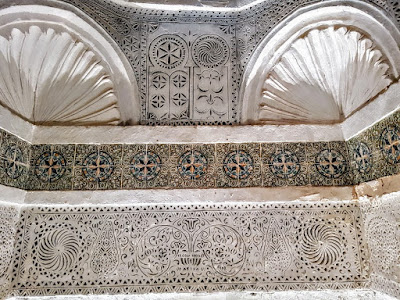Houmt Souk, chef-lieu de l'île de Djerba, possède aussi un musée de l'héritage, qui vient compléter celui de Guellala, déjà décrit. Ce musée se concentre surtout sur l'histoire, les traditions et les particularités de l'île dans son ensemble ethnique et culturel.
La visite du musée se complète par une autre curiosité attenante, consistant en une ancienne zaouïa jouxtant le bâtiment.
Houmt-Souk, which is the main urban community of Jerba, has also its own heritage museum that extends the contributions of the Guellala museum already mentioned in a separate article. Th Houmt-Souk museum focuses more on the history, the traditions and the characteristics of the island in its ethnic and cultural entity.
Houmt-Souk, which is the main urban community of Jerba, has also its own heritage museum that extends the contributions of the Guellala museum already mentioned in a separate article. Th Houmt-Souk museum focuses more on the history, the traditions and the characteristics of the island in its ethnic and cultural entity.
Le Musée de l'Héritage d'Houmt-Souk / The Houmt Souk Heritage Museum.
 |
| Carte de l'île de Djerba / Map of Jerba island |
La poterie de Guellala, au sud de l'île, est célèbre et est issue d'une tradition vieille de plusieurs millénaires.
The Guellala pottery-making in the southern part of the island is not only famous but also born from an old tradition dating back for several millenia.
 |
| Exemple d'une poterie gravée de symboles à la fois modernes et traditionnels. An example of a pottery bearing modern and traditional symbols |
Une autre particularité de l'île consiste en ses fondouks [فُنْدُق, funduq en arabe, signifiant 'hôtel'] ou caravansérails, dont plusieurs sont à Houmt-Souk.
The fondouk or caravanserai (a roadside inn) is another specific construction found on the island and particularly in Houmt Souk.
 |
| Costume féminin traditionnel de Djerba Traditional female costume of Jerba |
Djerba est également connue pour sa communauté juive, ainsi que pour une majorité musulmane de rite ibadite.
Jerba is also well-known for its Jewish community, as well as its Muslim population following the Ibadi rite of Islam.
La zaouïa du musée / The Museum Zawya.
Au sein de la religion islamique existe une confrèrie soufie désignée par le nom de ses lieux de rencontre [زاوية,] qui sont aussi le nom donné à la confrèrie elle-même. Cette tradition existe en particulier dans les trois pays du Maghreb.
Le soufisme [تصوف, tassawuf] est une tendance islamique empreinte de mystique et d'ésotérisme, qui est vraisemblablement à l'origine des marabouts d'Afrique du Nord: ce sont à la fois des érudits et des hermites musulmans, et aussi le nom donné à ces sanctuaires maghrébins qui essaiment le paysage.
Within the Islamic religion, there is a Sufi congregation that meets in a place called zawya, which by extension refers as well to the congregation itself.
Sufism is a mystic and esoteric aspect of Islam, most certainly at the origin of North Africa marabouts. They are both Muslim hermites and scholars, as well as the many shrines that characterize the Maghreban countryside.
 |
| Cet édifice est à moitié souterrain, semblant souscrire au mythe de la caverne. This type of building is partly underground, seemingly illustrating the Myth of the Cave. |
 |
| Les 5 symboles d'une porte extérieure |
 |
| Voûte intérieure de la salle principale The inside dome in the main meting-room |
 |
| Vue de la salle principale A view of the meeting-room |
 |
| Décoration murale d'une chambre annexe Mural decoration in a sideroom. |
Christian Sorand








No comments:
Post a Comment